This text was created by gg editorial staff for the benefit of its readers, with the partner support of the advertiser, Samsung. The advertiser has no influence on the editorial opinion, but is interested in making you more aware of the possibilities of the whole ecosystem of SmartThings devices for comfortable life and productive work.
It is difficult to determine when the term "smart home" first appeared, as the idea of automating and controlling home systems was born almost simultaneously with the development of electronics and computer technology. Back in 1949, Claude Shannon and Warren Weaver in their book "Mathematical Theory of Communication" described the idea of an automated home that could use electronic devices and sensors to detect and control home functions. But what do we mean by that now? Why aren't all of our devices working as an integrated part of a smart home so far (or are they already working, but we either don't know about it or don't see the point of using the features that are already there)? And when will that happy moment come when our homes become as smart as in sci-fi movies about the future?
The Main Smart Home Challenge No One Tells You About: Fragmentation
It's really not that difficult an engineering task today to add a wireless communication module to any device, create an app and teach it to somehow interact with the gadget and provide all status information or control via smartphone. And we have been seeing it all for quite some time, from light bulbs and sockets to kettles and robot hoovers.
But what does it all look like on the user experience side? Each new smart light bulb requires its own separate app to be installed. If you count the number of electrically-powered devices in your home, the output is probably several dozen apps that need to be installed. Of course, some of them can be created by a single manufacturer, which will reduce that number, but it's still a lot. Plus, most of these apps will control one or two functions (turn lights on/off, set a colour temperature, determine the temperature for a thermopot, etc.). If you need to get water at 40 degrees to make baby formula in the middle of the night and feed the baby, you'll probably do it. And you will do it every night and several times a day. But otherwise, you'll very quickly play with these modern technological toys and one day, when you pass a robot hoover and decide to run its cleaning program, you'll realize a simple thing: just bend over and press a big button (maybe even the only one) on its body instead of reaching for your smartphone, searching for the appropriate app on it, waiting for it to connect to the hoover via a cloud service and, finally, running its cleaning program.
The usual human laziness and comfort that has always been the engine of progress will work in reverse, and you'll revert to "analogue" life in using a digital and smart device.
The Power of Ecosystem: Why All Manufacturers are Moving in This Direction
What if all smart home devices were combined into one app - would that solve the problem of fragmentation, at least partially? Probably yes, because using one app and dealing with one familiar interface logic would be convenient.
It's not a whim of device manufacturers (okay, it's not the only one) who want to tie you to their brand and make you buy only their technology forever. It is precisely a matter of convenience - everything is always familiar and easily accessible. And also the value of any ecosystem grows with the number of its objects, which is clearly demonstrated by social networks - the more users they have, the more opportunities for communication in them each user gets.
Ideally, the world should reach an open architecture that allows small producers of a single (but useful) device to gain immediate access to a significant audience of users. This is easily understood if we draw an analogy with the open architecture of personal computers, which was started by the IBM PC platform forty years ago. What do we have now? Unified interfaces, allowing any (almost) computer component to be made by any manufacturer. This is how humanity got a multitude of motherboards, graphics cards or storage devices from a variety of manufacturers, which started a competition for users' wallets, where the best devices got the favour of buyers.
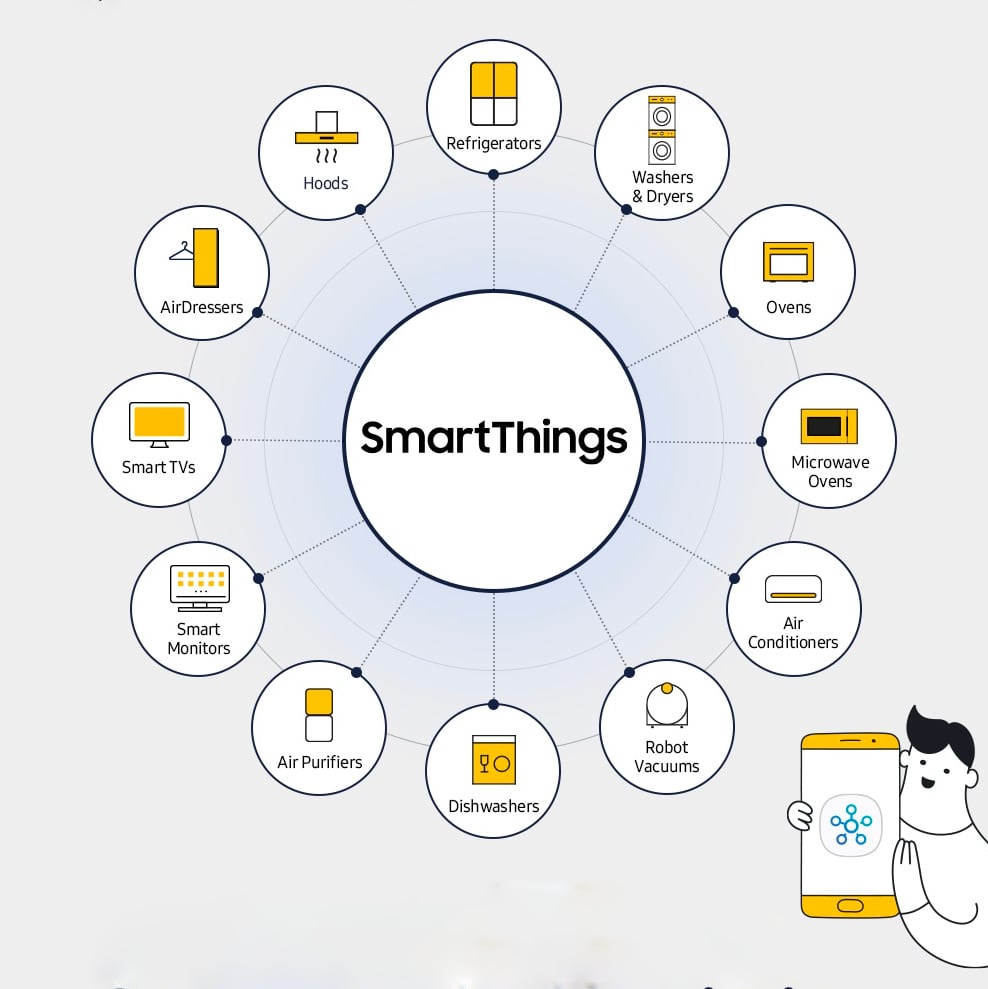
Unification will Save the World of Smart Homes: Advent of Matter
Any new and useful technology has gone the way of unification and creation of universal protocols. This is true of all the technologies that are an integral part of our lives today: USB, Bluetooth or Wi-Fi. All of them have gone this way from childhood illnesses to seamless and convenient use and full compatibility of all with all. I remember the problems of the first USB devices at the turn of the millennium, when some devices were not compatible with the computer. Or I remember testing the first commercially available Bluetooth headsets back in 2002 (monaural, of course, hardly ever made now). Connecting each one to a phone (not yet a smartphone) with Bluetooth was quite a challenge. The Bluetooth standard was just emerging, and one manufacturer's headset might not even connect to another manufacturer's phone. Today, this seems fantastic because we are used to how wireless headphones and a smartphone from one manufacturer can easily connect to each other without even switching to Bluetooth settings - the smartphone will display a message inviting the user to connect the new device, and all that is left is to press a button.
Something similar is happening right now with the unification of smart home devices (and indeed, all Internet of Things or IoT devices). Major competing device manufacturers are teaming up to make unified industry standards and data exchange protocols for all such devices. This standard is called Matter, which is being worked on by CSA (Connectivity Standards Alliance), which already includes several hundred companies. It brings together the main communication standards used by device manufacturers - Zigbee, Z-Wave, Thread and Wi-Fi. And the creation of the standard is happening right now - version 1.0 was released on October 4, 2022, and the first update to version 1.1 was released on May 18, 2023. I can assure you - you'll be seeing this Matter symbol in the form of a stylised triangular star more and more in the coming years.
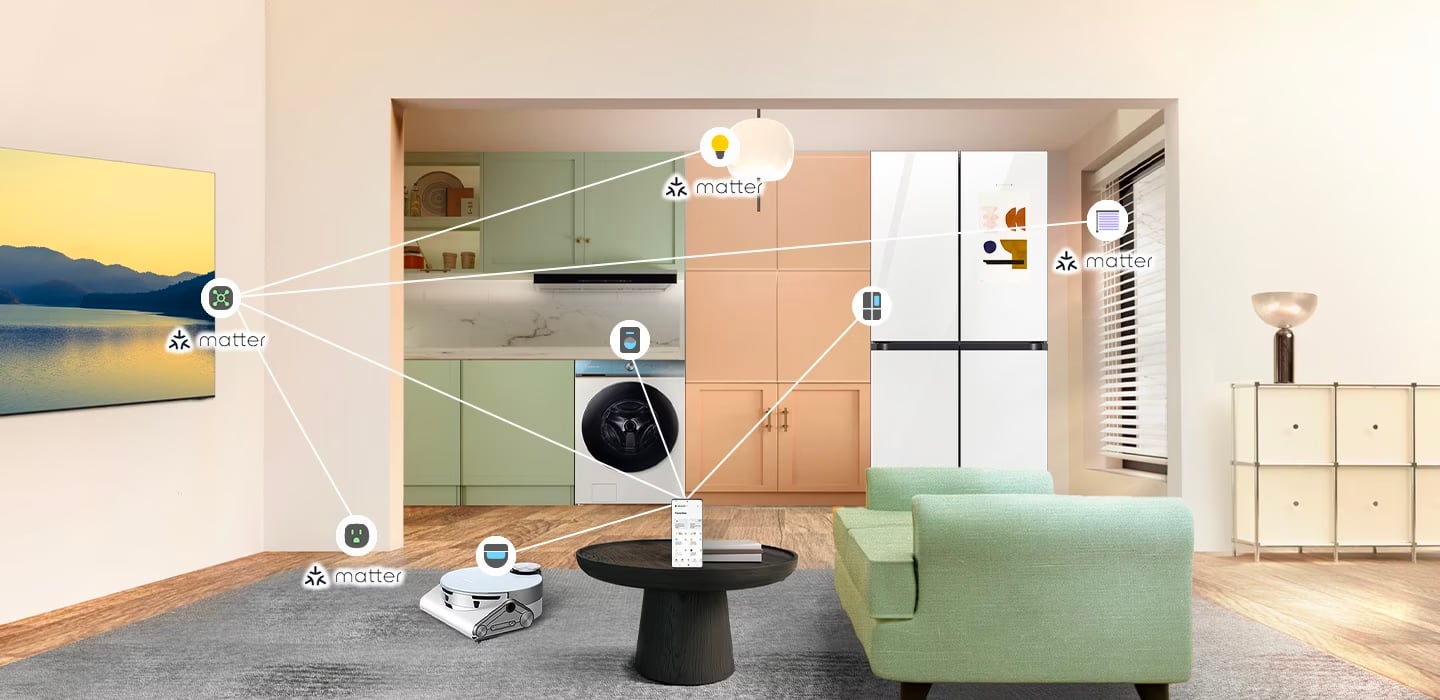
The Matter Label will Become As Well Known As the Bluetooth Label in a Few Years
A head start in the race: why Samsung SmartThings has the advantage now
- It's no secret that all major technology companies have been building their own device ecosystems for years, but it's Samsung with its own SmartThings platform that has a pretty big head start and a great chance to succeed in this race due to its unique global market position. The largest smartphone manufacturer in the world. It's the starting point for all smart devices and services (we call a taxi or rent a scooter with a smartphone, too). Right now, a few more places of "gravity" are forming in the smart home - the TV (or smart monitor) and the refrigerator. They, too, have a display and an operating system, allowing for a smart home hub. And (surprise surprise) Samsung is no longer just planning to produce them, but also manufactures such TVs, monitors and fridges.
- Presence in every home - even if you don't have an air conditioning or a dishwasher, for example, there are still household appliances like a TV, refrigerator, washing machine or microwave that form the basis of the modern concept of comfortable living. Purely statistically, you already own at least one Samsung appliance. And the rest of the world does the same, there are no exceptions.
- The large number of smart home devices already available - everyone knows Samsung as a large company - a player in the global market. But South Korea's home market is a playground for the company to test the latest devices before launching its global expansion. Unsurprisingly, Samsung has been making home appliances in South Korea for a long time (and is constantly creating new classes - the AirDresser steamer, for example, is fairly recent). All of these are already in production and allow the company to gain expertise in different market segments and enrich the user experience for its consumers.




- Ecosystem is already working and growing every month - If you have bought a Samsung household device in recent months, there is a non-zero chance that it is already part of the SmartThings ecosystem and supports control from a smartphone or TV. Dozens of Samsung devices with SmartThings support are already on the shelves of Ukrainian shops. In total, as of autumn 2022 Samsung has already reached 10 million SmartThings devices sold and 230 million users with the app installed. A significant number of new devices that are currently in development and will be available this year or next have SmartThings support too. You can check this by installing the SmartThings app (if you have a Samsung smartphone, you already have the app in your smartphone). And more than 300 companies that develop IoT devices and services have already joined the SmartThings ecosystem.
- Automated Device Scenarios - A unified ecosystem of devices has another key advantage: they can interact with one another without direct human control. The scenarios created allow us to surround ourselves with the real magic of technology - when an event (it could be a certain time, or some action that comes in accordance with the user's movement or, for example, depends on weather conditions or the climatic state of the house) is not even a single action, but a chain of actions defined by the user. In this way you can not only influence the comfort of your home, but also automatically control lighting, climate settings, volume of running devices, and the like.
How to Add a New Device to SmartThings?
To find out if you have SmartThings, install this app on your smartphone (it is available for Android and iOS ). If you have a Samsung smartphone (or smart TV), you probably already have this app installed. Among Samsung SmartThings devices certified in Ukraine there are already dozens of TV models. And then there are soundbars, steamers, refrigerators and freezers, cooktops, upright hoovers, ovens, smart monitors, projectors, air conditioners, air cleaners and dehumidifiers, washers and dryers and robot cleaners.
To add a new device, you must launch the SmartThings app, select the Devices section and press + in the upper right corner of the screen. If you have a Samsung device, it will most likely connect itself to your smartphone and you will see a pop-up window inviting you to add the device. The same happens if you start scanning for devices nearby. But you can scan the QR code on the device itself or select it from a list (by type or brand).
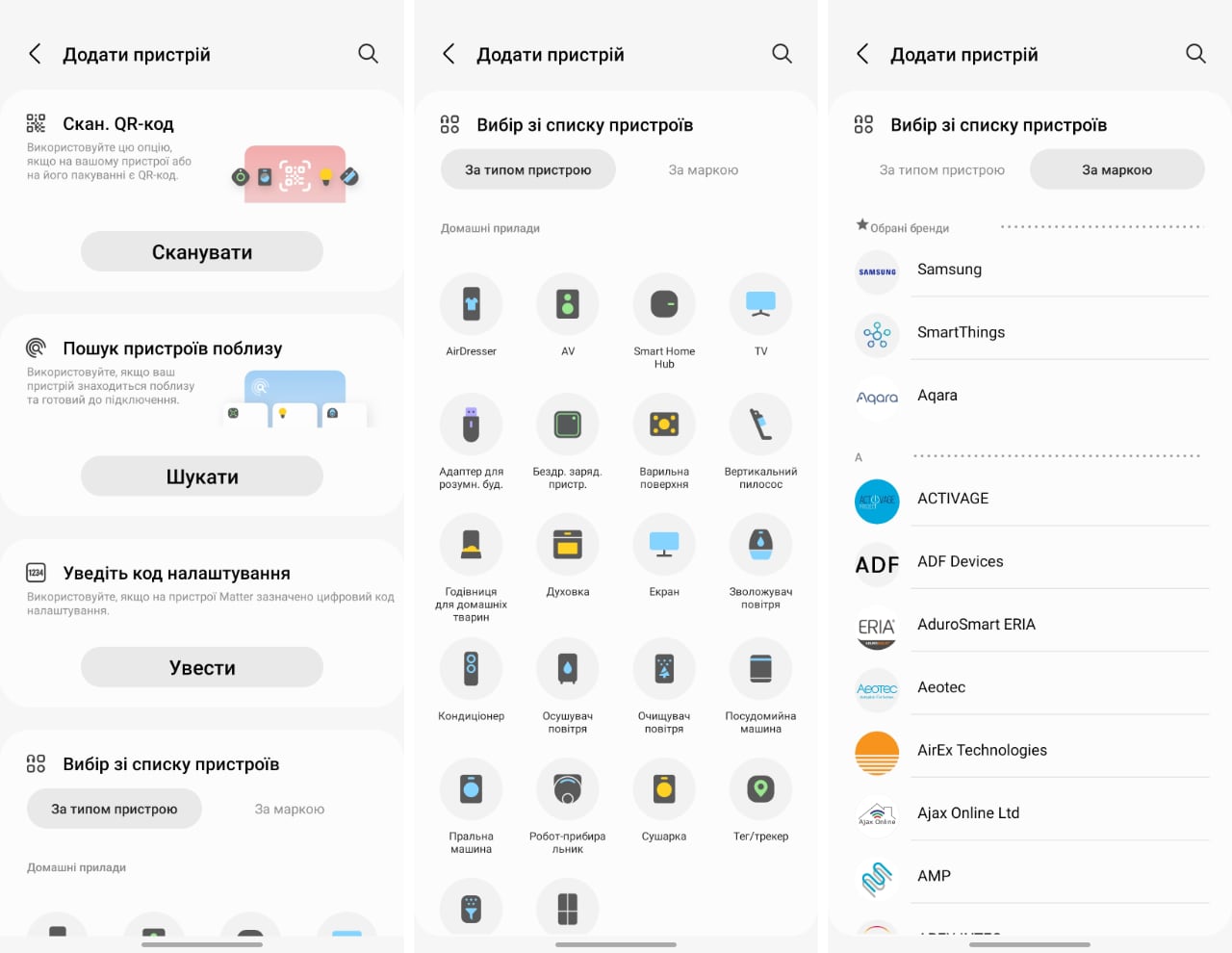
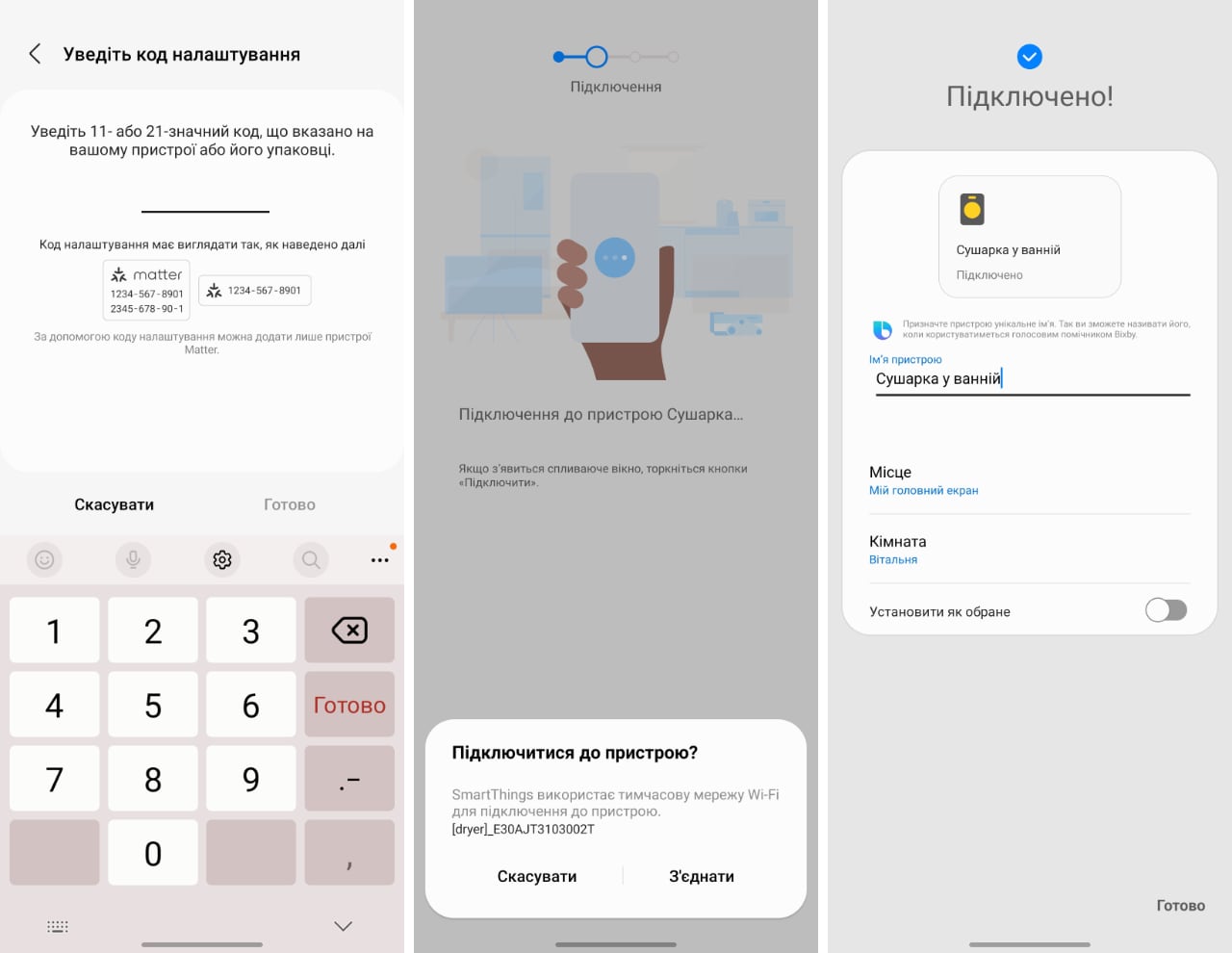


What SmartThings Devices Can Do Today
The main idea behind smart home devices is to improve comfort and quality of life. And if not a complete deliverance of mankind from the chores of the household (I am sure that is yet to come), then a reduction in the time we spend on household activities at home. For example, let's choose something not trivial and not the most common (how to set up a smart TV or monitor, readers of gg already know). Here's what the dryer control looks like in the SmartThings app. This is a clear demonstration of the benefits of using the app via a smartphone rather than by selecting the appropriate programme with the buttons on the panel. Because the app always provides more control options for SmartThings devices. In addition, notice how well everything is visualised.
In addition to the standard operating modes of the dryer, for which no app is required, you can create your own operating mode, even if you only need to use it once. Of course, the developers of household appliances cannot make a list of programmes for all occasions, but they can create (and already do, as you can see) visual algorithms to best achieve the exact result the user needs. You can select the type of garment, one of the three drying power levels, and activate anti-folding mode if needed (saving you time on ironing, too). The list of available options doesn't fit on one screen, and the time required for the programme is immediately visible before it's sent to the machine. Plus, you can enable a notification - it will come to your smartphone or SmartThings TV while you watch a new episode of The Mandalorian while waiting for your clothes to dry.
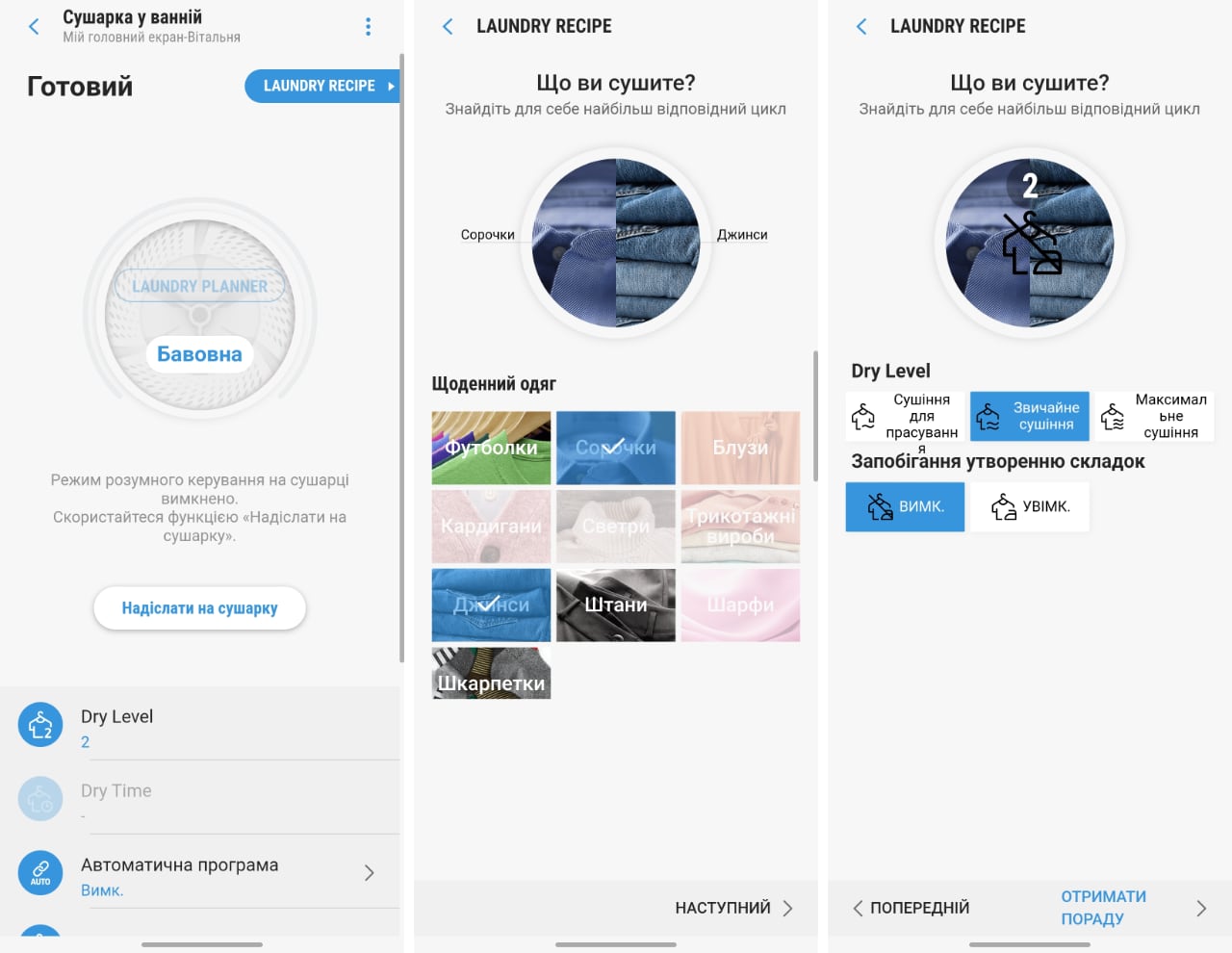



Another example is the Samsung smart air conditioner series WindFree. At first it seems that the app only duplicates the capabilities of the remote control: it allows switching the device on/off, adjusting operation modes and changing the temperature in the house. But the app also allows you to change operation modes according to a weekly schedule, receive notifications and switch on the air conditioner when you approach the house (Welcome Cooling), and switch on recommended scenarios to save energy when no one is home. In doing so, a smart balance can be achieved where electricity is not wasted and the air conditioner can be switched on before the user enters the room.
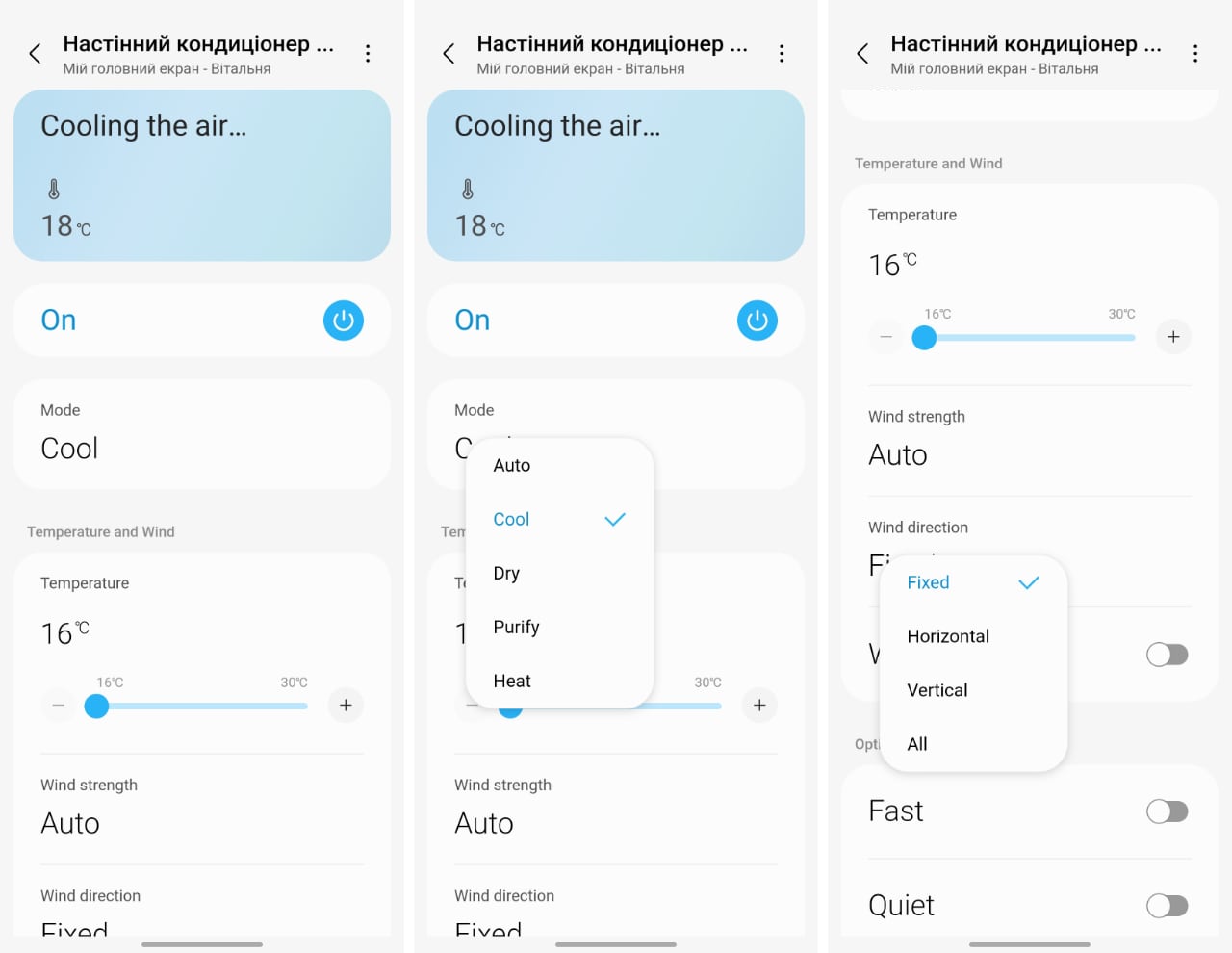
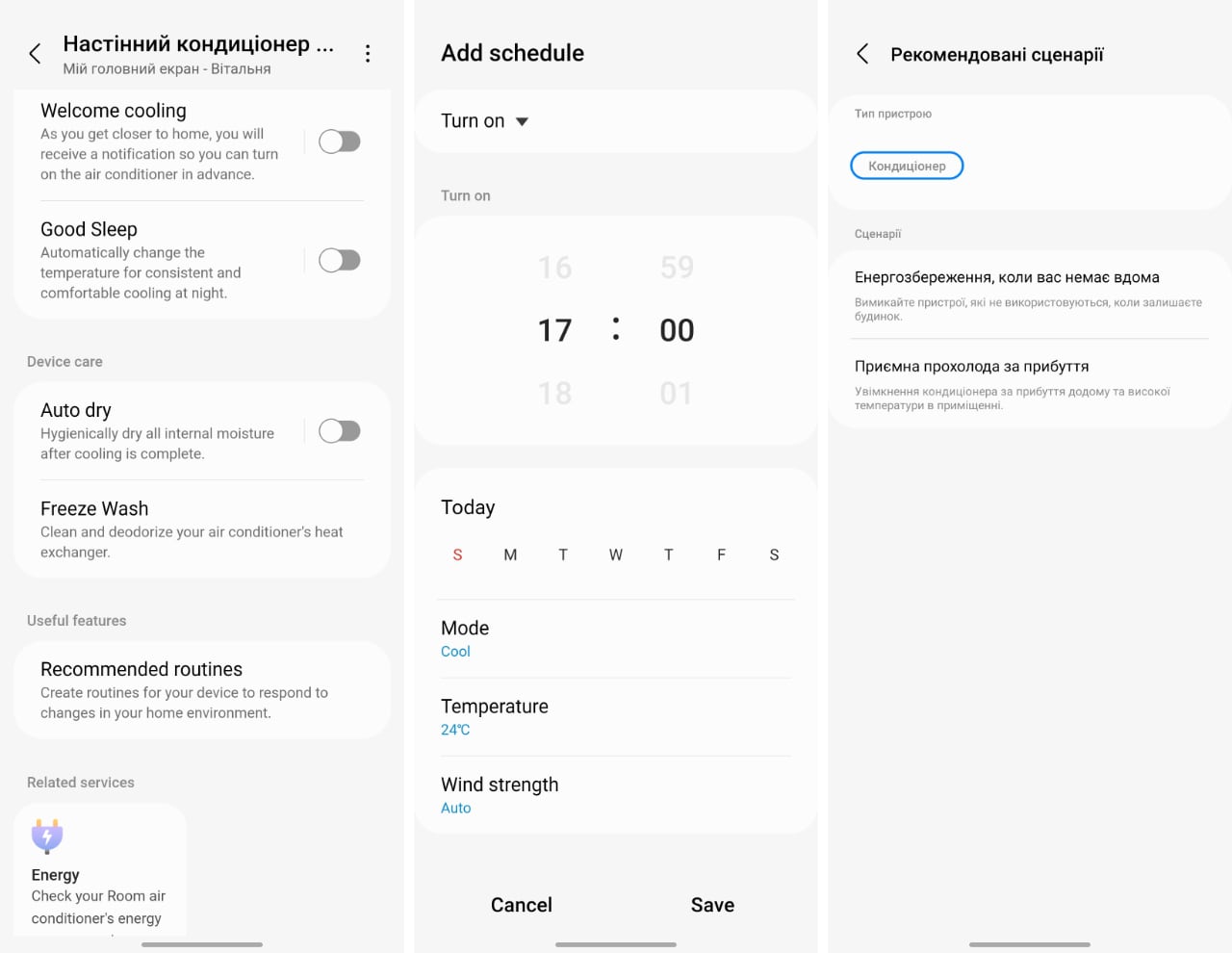


SmartThings Automation Scenarios
All SmartThings units can work together and perform certain actions according to predefined automatic scenarios. This enables you to achieve a new level of comfort and enjoy the world of the future today. Let's create a simple scenario for an example. When we turn on the TV, we want to run the dryer cycle, turn on the air purifier in the living room, where the TV is, and set the temperature of the air conditioner to 20 degrees in WindFree mode (this is a special mode of this air conditioner, when it creates a soft air flow evenly distributed through tens of thousands of micro holes, so there is no draft or feeling of wind).
A simple and clear algorithm If-To is used to activate it, the user must select the device that activates Select the activation state (living room TV on) and then add all the other devices that should change their activation state to another. We successively select the connected devices and select the appropriate changes in the settings and save the script. The scenario can be changed at any time. For example, you have also bought a robot hoover and want it to stop its operation while watching TV. Simply connect the new robot cleaner to the app and edit the scenario by adding a new action with the robot returning to the charging station.
You could say that this scenario is fictional, but if you ask yourself in what conditions we like to watch TV, eat breakfast or exercise, you will find that it is somehow related to the room temperature, the lighting and the noise level from household devices. So it's the automatic scripts that allow us to free ourselves from this routine and set things up as we are used to without our intervention. Everyday.
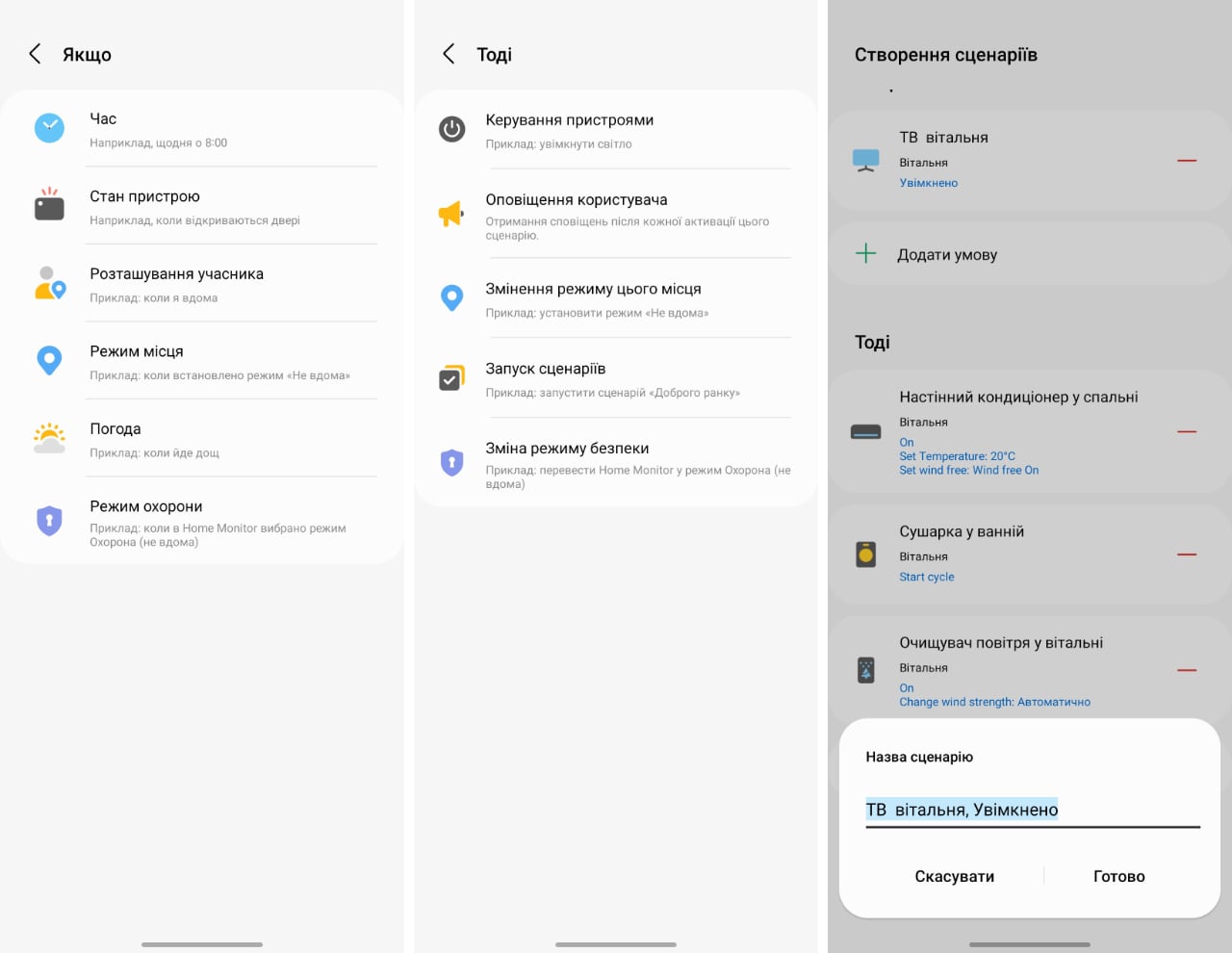

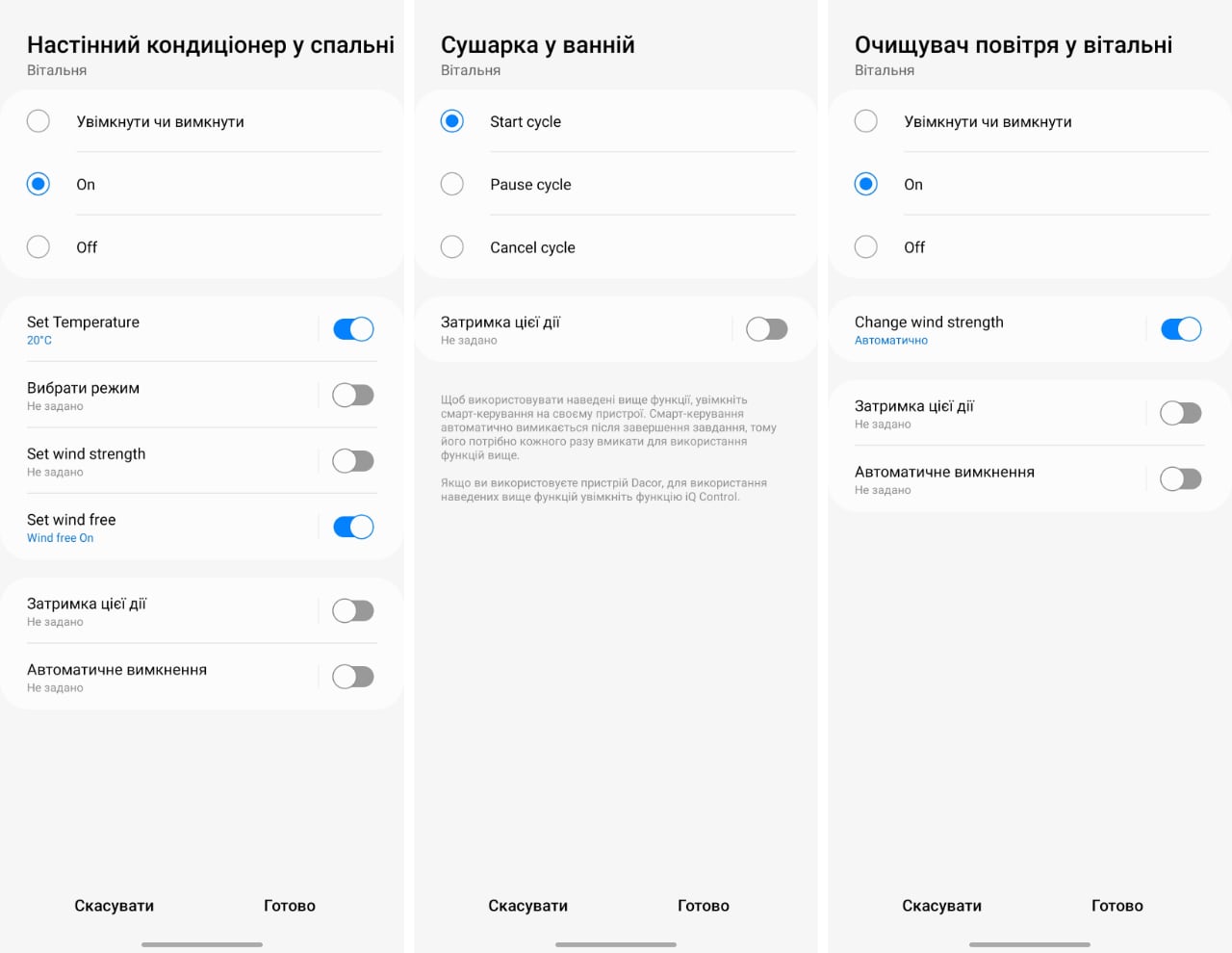
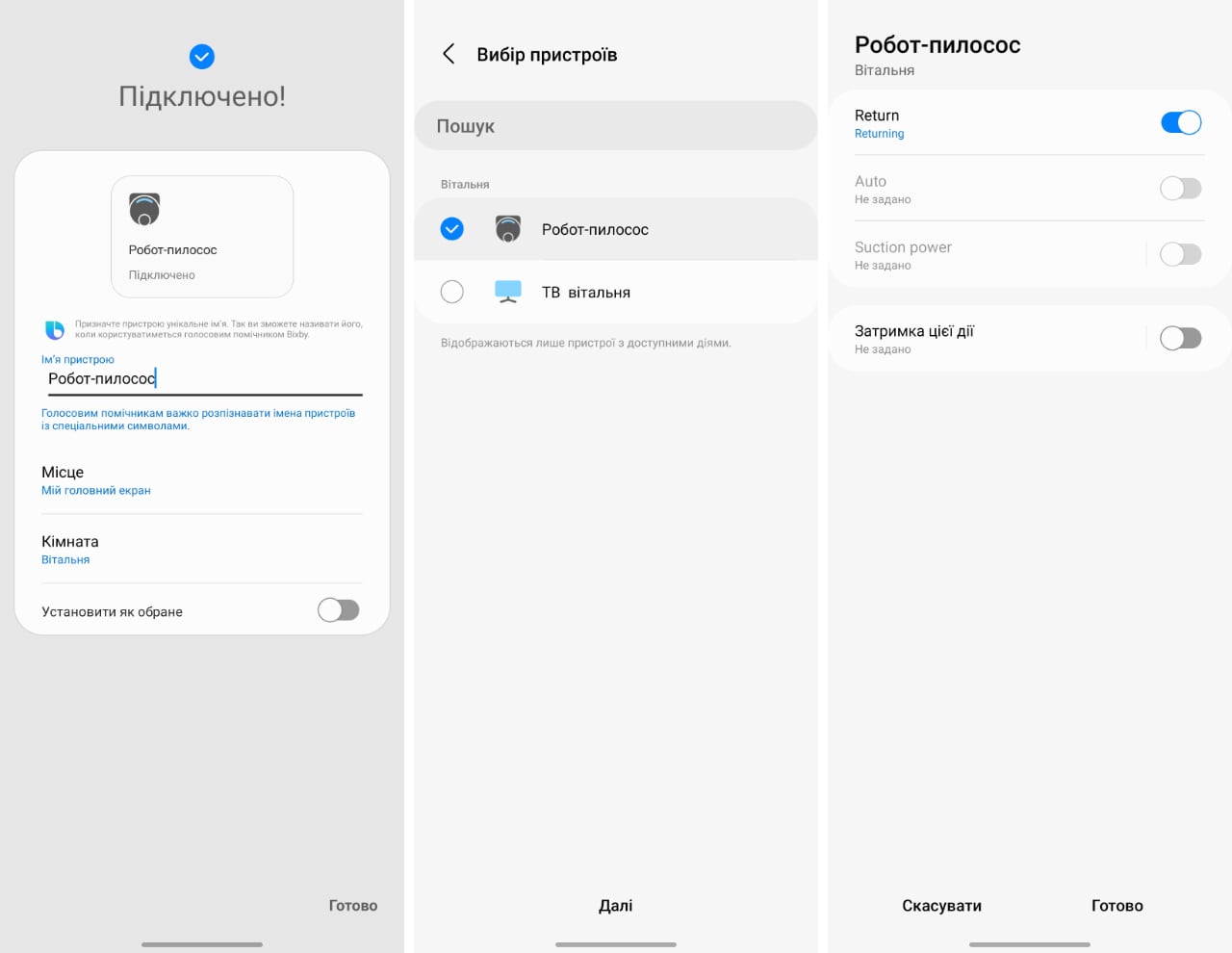




SmartThings Development Directions
A smart home is quite a layered concept, covering all areas of our lives from work and leisure, pet care to health, comfort and coziness and cooking. This is why Samsung separates all automation devices and scenarios into several areas.
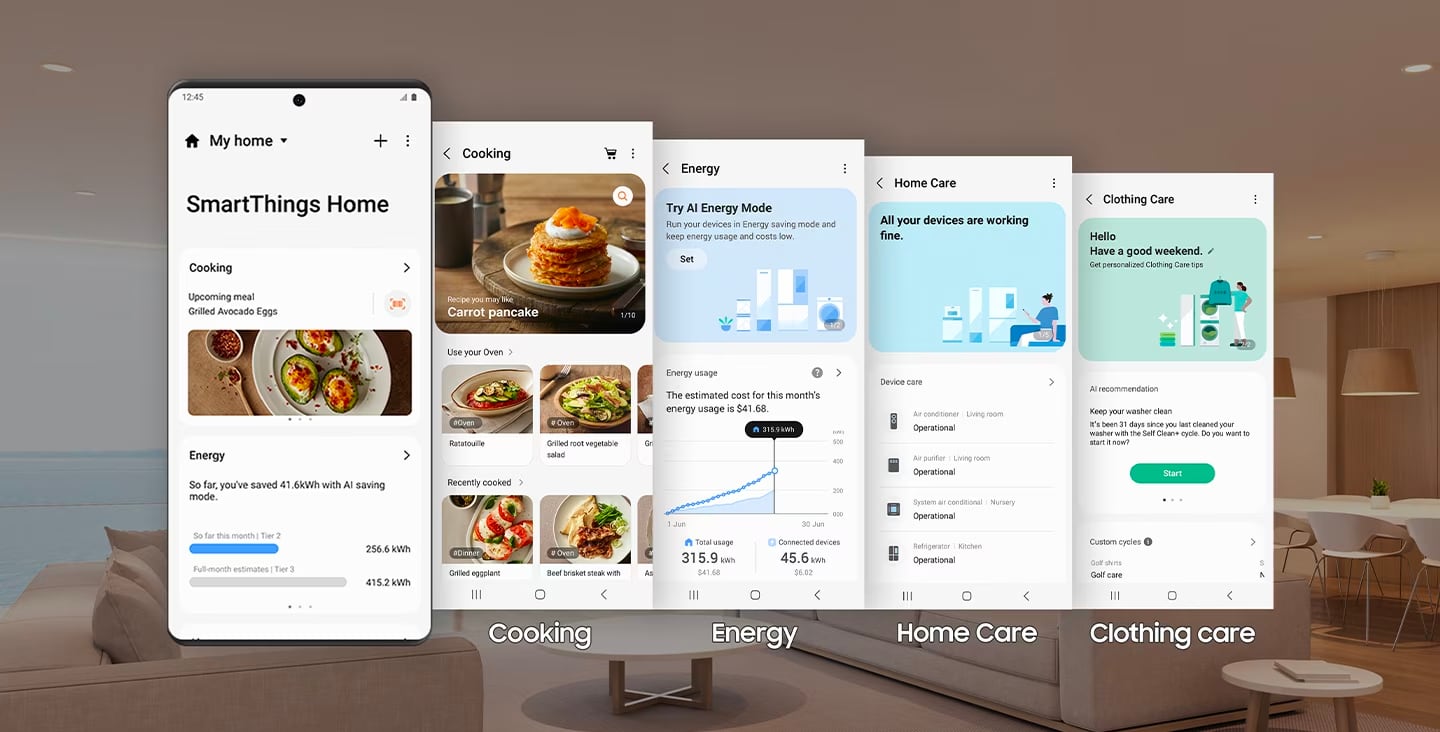
Physical Fitness Care
SmartThings devices allow you to maintain physical fitness, can replace a coach and create your own workout schedule to achieve these goals: choose specific exercises and set the mobile screen display on your Samsung TV to see exactly what exercises to do. To do this, you will need to install the Samsung Health app, which will provide additional features. For example, the smartwatch will monitor your physical condition and perform any necessary movement calculations. The result can then be seen in the app in the form of charts and observe the progress of your workout.
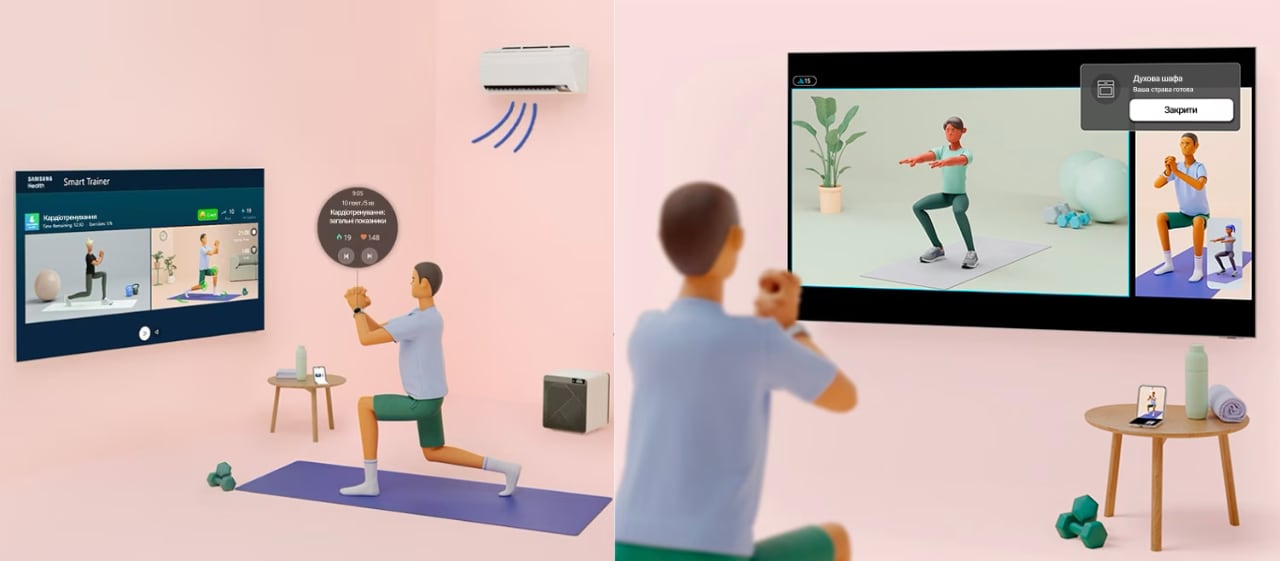
Cooking
Healthy eating is an integral part of modern life. And the SmartThings app is already trying to help us with healthy eating together with smart gadgets. When combined with Samsung Health, it provides data not only on calories lost but also on calories gained. And it also allows us to balance food according to needs, food preferences and even the contents of the fridge (provided that the user carefully records all their purchases, of course). The app also lets you keep better track of how long food stays in the fridge, which is good for your health. And the app also lets you search for recipes that match your preferences.
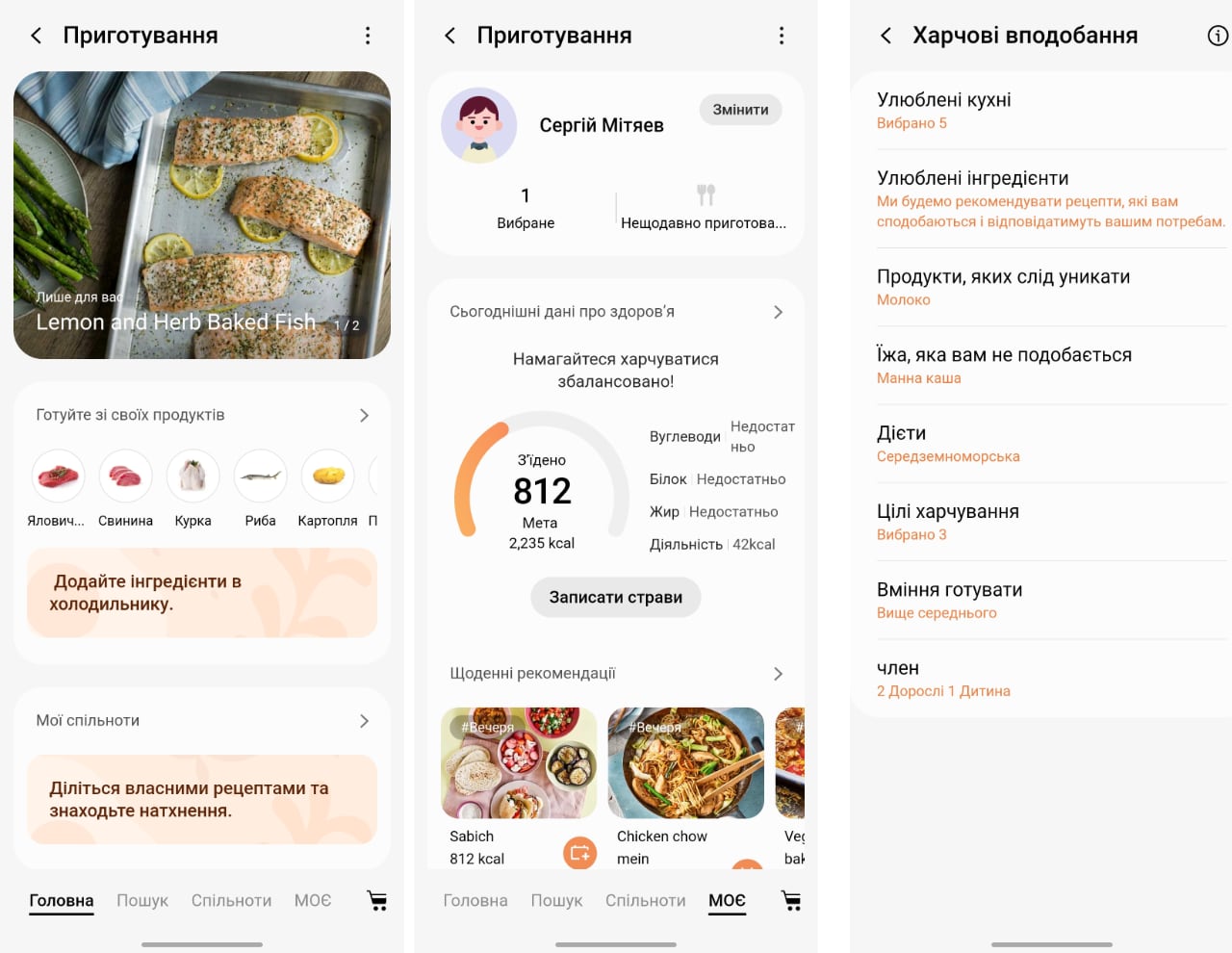
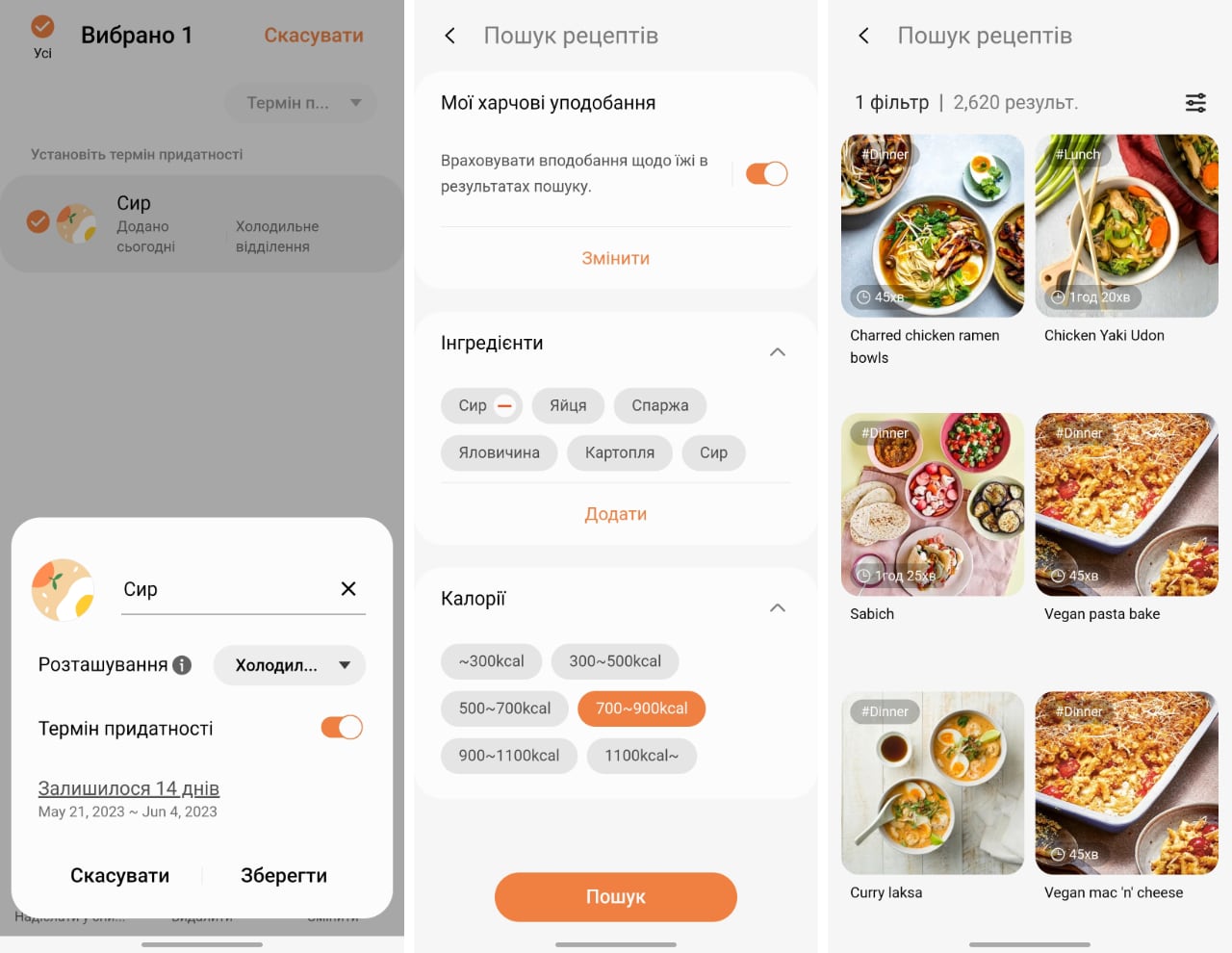
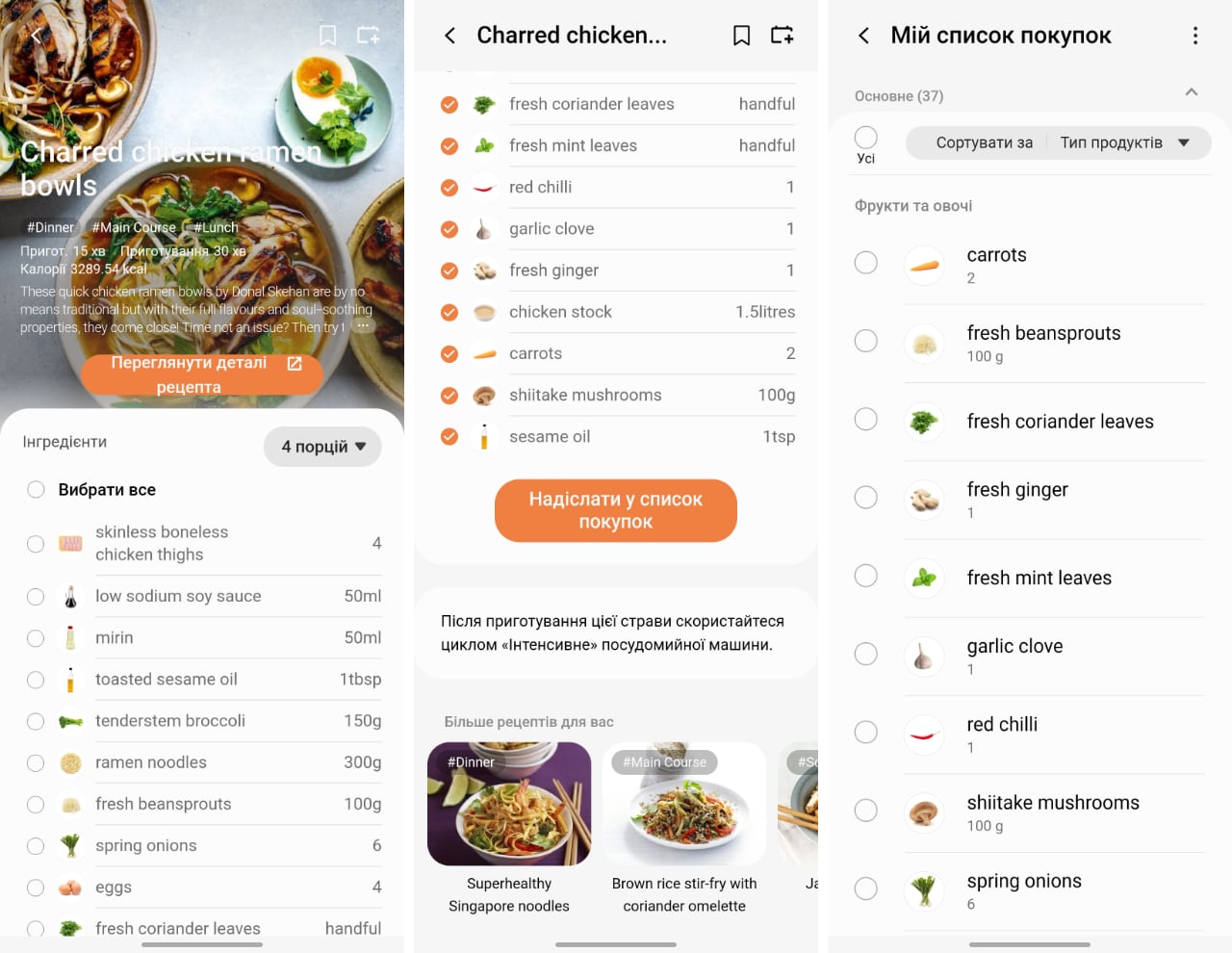



Work at Home
Work is (unfortunately) still an important part of our lives. That's why SmartThings should help with it. The Eternal Revolutionary: Samsung Galaxy S23 and Galaxy S23+ R eview for example, you can actually do some of your work even without a working laptop. You can join a video conference live from your smart TV (or smart monitor) and use the front camera of your own smart phone for video (of course, to do that, the smart phone needs to be paired with the TV via the SmartThings app). And you can also easily send files from your phone to a Windows PC and work with it remotely by connecting a keyboard and mouse to your smartphone, and all together to a smart monitor.
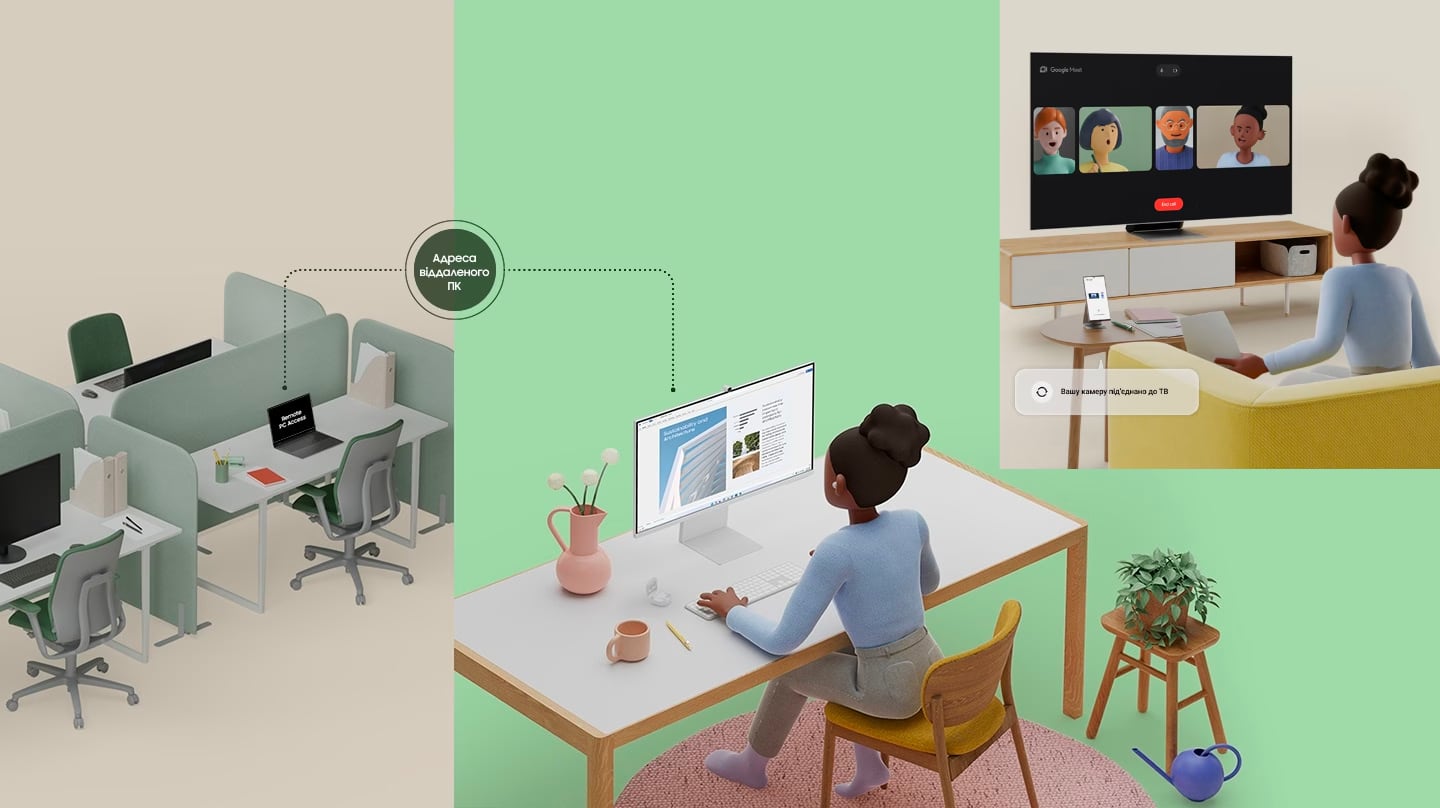
Climate Control and Comfort
One way or another, we like to surround ourselves with different environments for different exercises or relaxation. Sometimes we like bright lights and loud music. Sometimes it's the opposite: dim lighting and silence. Sometimes we want to keep the air in the house cooler or cleaner, and sometimes we want to keep warm. A separate area of SmartThings' development is therefore the creation of moods, which exist for us according to the situation (by the way, note how this is implemented in the modular projector The Freestyle). They are different for everyone, so the configuration of automation scenarios will be different for everyone.
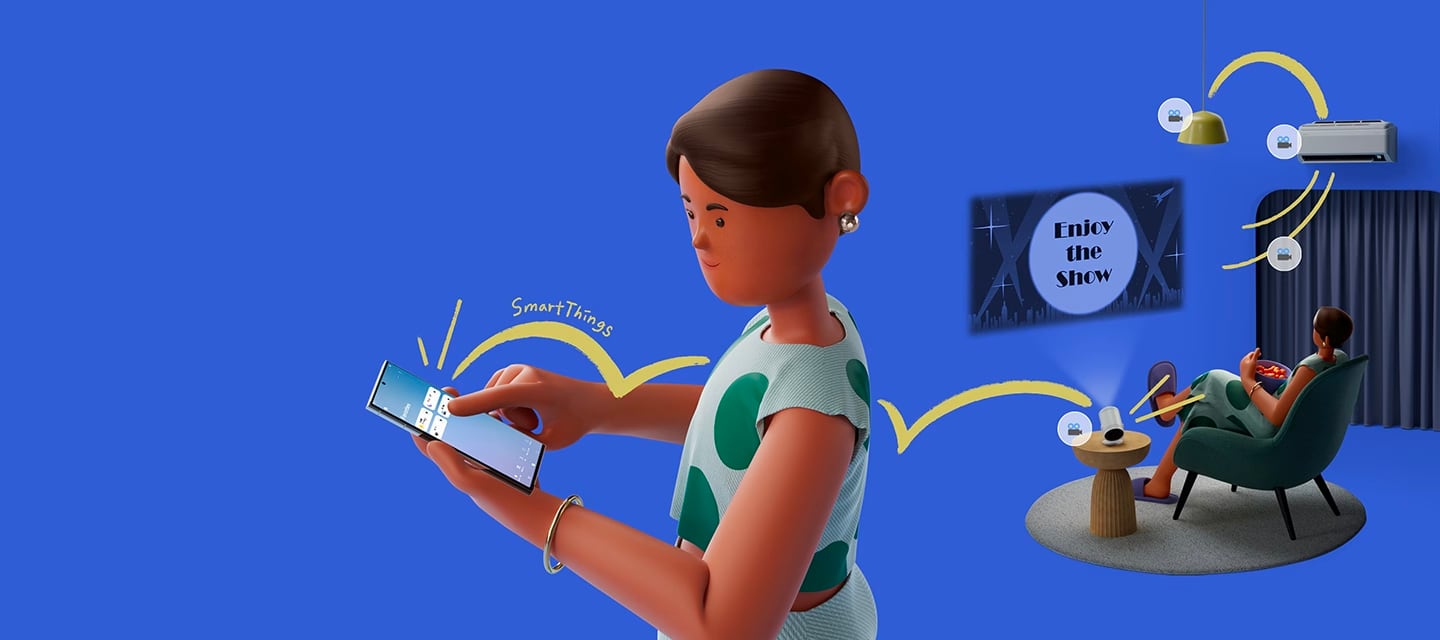
Pet Care
Many people have pets. By the number of cats in general, Ukraine is one of the top 10 countries in the world. So it is not surprising that SmartThings offers separate options for the care of your furry pets. You can monitor their weight and food intake, and integrate scenarios with, for example, air purifiers or automatic feed dispensers. For example, a cat or dog can be monitored using the camera of a Samsung Jet Bot AI+ hoover.
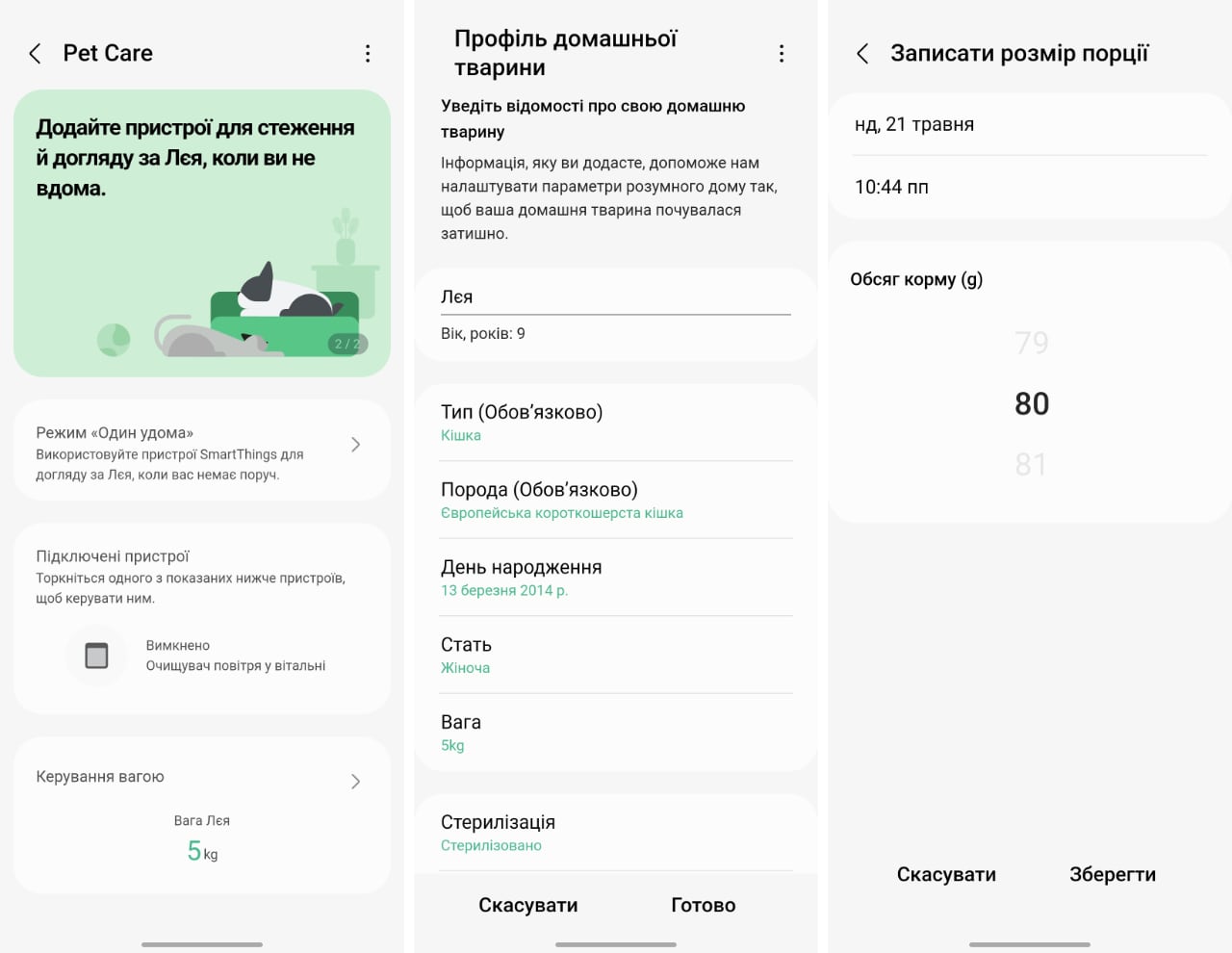
Saving Energy
Smart consumption is also becoming a part of our lives and is not just about Greta Thunberg. The SmartThings app can help you keep track of your energy consumption and avoid unnecessary use. For instance, it will send you a message if you don't close the door of your smart fridge, or let you know which smart appliances are using a lot of energy when you're not home. You can view a month's worth of statistics and change the modes of your devices in a few clicks. You can even set the actual cost per kilowatt in your home, set monthly spending goals, and track your progress.
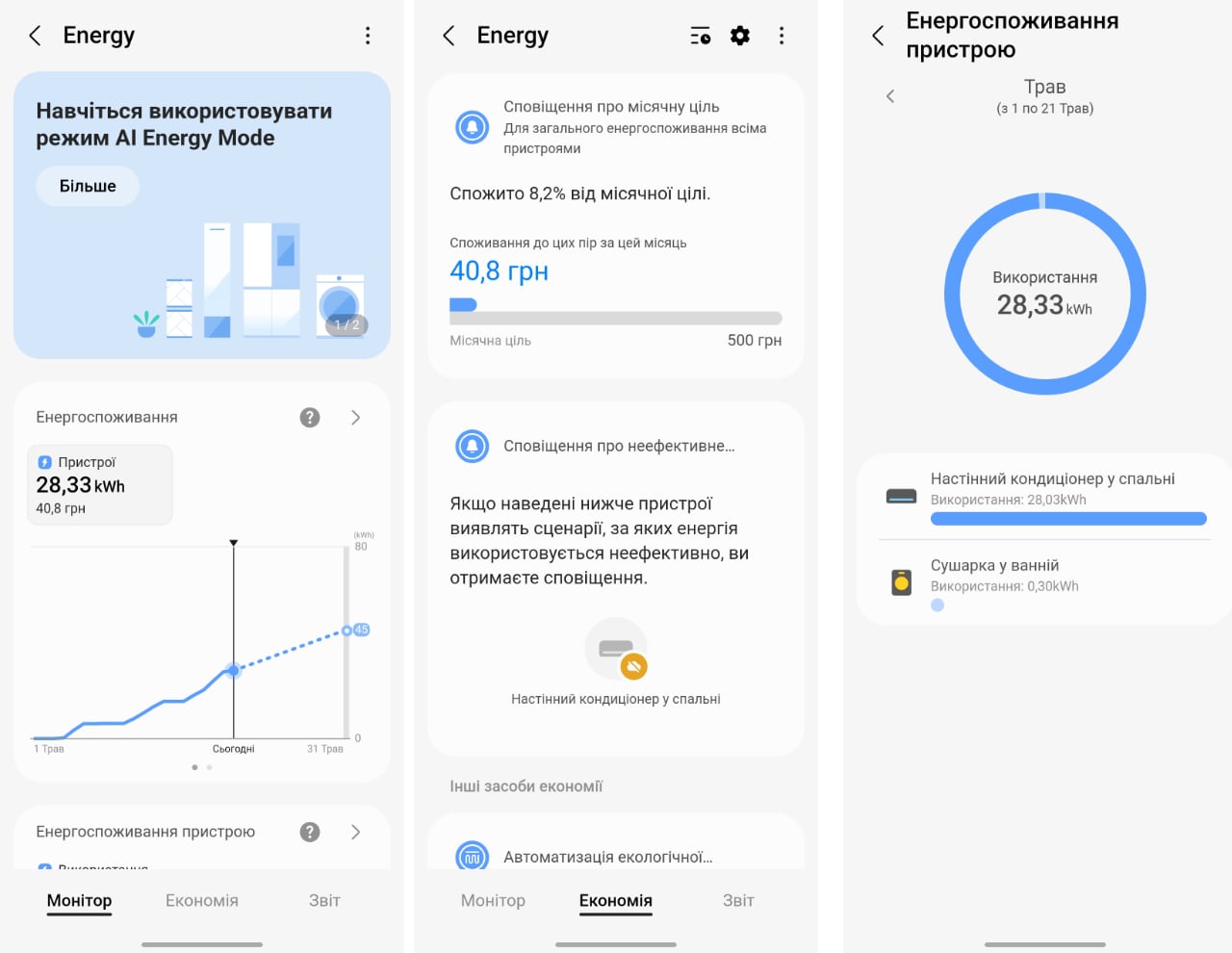
The Future of Smart Home
Of course, we're now at the beginning of the transformation of our homes into smart homes. The fun part is yet to come. Let's fantasise about scenarios that seemed fantastic a decade ago, but are now technically already realized (or will be realized) in the global market:
- You open the fridge and see that you're out of milk. You close it and place your order with a couple of clicks on the display mounted on the outside of the door (this is how the Samsung Family Hub series would work).
- You are waiting for your friends to come to a party, some of them are already here and enjoying themselves in the living room, while you are finishing making sandwiches in the kitchen. The doorbell rings - you see the video from the smart doorbell camera on the kitchen fridge screen and activate the lock with your voice to open the door for your guests.
- With your shopping list you navigate through the supermarket shelves and can't remember if your child's favourite juice is out. You activate the fridge camera on your smartphone and see if there is an ample supply of juice.
- You are a little late getting home and your friends are already waiting for you at the door. You send them a one-time and temporary digital password via a secure connection, which opens the door and lets them in before you get home.
- Your clever oven analyses the list of food in the fridge and suggests three possible meals to make in 40 minutes.
- You return from a winter holiday after a long journey. Half an hour before you arrive, you send a "maximum relaxation" script, according to which the house is set to the optimum temperature, the bath is filled with water of a certain temperature and the coffee machine makes your favourite coffee as soon as you cross the threshold.
5 Things You Should Know about Samsung SmartThings Today
-
This is the concept of connecting all devices in a smart home, which in the form of the SmartThings app already exists now, is installed in every Samsung smartphone and is supported by many Samsung devices (perhaps even those that you already use at home on a daily basis).
-
A significant number of new Samsung devices coming to market this year (and beyond) will support SmartThings. These are dozens or even hundreds of models of household devices: televisions and air conditioners, washing machines and dishwashers, ovens and humidifiers. This number of devices will grow every month due to the hundreds of companies that already produce various motion, temperature or humidity sensors and motors for blinds or garage doors.
-
Smart Things devices can interact with each other through automatic scenarios, the number of which is limited only by the imagination of the user. And they make life more comfortable and convenient (which is exactly what the smart home concept seeks to achieve).
-
Thanks to the new unified standard of smart devices Matter, which is already supported by SmartThings, the number of smart appliances is not limited to the production of Samsung. Therefore, it does not limit its user experience only to the Samsung ecosystem, but instead provides an additional degree of freedom in the choice of tech. And you may already be using Matter-enabled appliances.
-
The larger the home fleet of smart appliances that support SmartThings, the greater the benefit of their collective interaction. That's when they all add up to more value than the combined benefits of each individual device.
